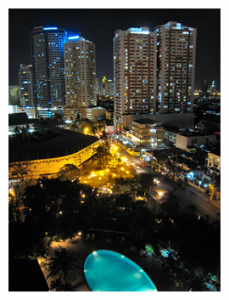MobiLearn Asia 2013
2nd-3rd October, 2013
Singapore
[Continued from Day 1 blog post]

‘Planet’ by Marc Quinn, Gardens by the Bay, Singapore. Photo by Mark Pegrum, 2013. May be reused under CC BY 3.0 licence.
In his keynote on the second day, Mobile Learning in South Asia: Perceptions of Progress, Possibil-ities and Potential, John Traxler suggested that mobile learning has shifted from being the concern of the e-learning research community to being a universal given because of the wide ownership of mobile devices. The early, short-term mobile projects run by enthusiasts in the past don’t necessarily tell us much about the future, where there will be large-scale, widespread usage. However, there are lessons to be learned if we look critically at the past.
Traxler suggested we have achieved at least four things with mobile learning:
- We have managed to extend the reach of education to underserved communities. A lot can be achieved with older, simpler technologies. However, we can’t make assumptions about how young people, or any other group of constituents, want to use mobile tools. We have also extended the reach of education to those with small chunks of downtime in everyday life, who can spend that dead time learning; to non-traditional learners, who don’t have experience of formal education; to nomadic learners, such as gypsies and travellers; and to those with disabilities and special needs. Inserting ‘our’ education into these other communities is however problematic in some ways.
- We have managed to promote different kinds of learning, involving collecting data in the real world, or augmenting our learning with AR and similar technologies. When people use their own devices, the latter can learn about their owners’ histories and past educational experiences.
- We have created far more opportunity for a wide range of people to produce educational materials outside conventional learning institutions. However, this may require users to differentiate between reliable and unreliable sources and triangulate offerings, which may be challenging without a solid academic background.
- We have moved on from seeing m-learning as a kind of e-learning on small computers. We should be careful of seeing learning as being about content, and treating mobile phones as USBs into which we stuff as much content as possible. We also need to be aware of the danger of scaling up projects by simply replicating the same content across multiple contexts. Access to particular content, and particular languages, comes at the expense of access to other content and other languages.
In her talk, A Future-Back Look at the Use of Mobile Devices for Enhancing Learning, Katrina Reynen from Optus argued that the integration of ICTs into the curriculum is one of the most challenging tasks facing schools. We need to figure out what content should be in the curriculum, what pedagogy is appropriate, and how students can best learn with technology. It’s important, she suggested, that we don’t start with aims like getting students to make Prezis or write blogs, but rather with aims like raising awareness or helping students to ask critical questions. Exemplary learning environments have technology available for learning, rather than being technology-focused.
In the second panel discussion, Disruptive Learning and Open Education Resources (OERs) – Promises and Challenges, Geoff Stead (Qualcomm), Grainne Connole, John Traxler and Gerald Cai (Samsung) discussed the role of disruption and openness in contemporary education. John Traxler asked whether the disruption is just minor and can be incorporated into education, or whether we are talking about something much larger, such as a paradigm shift. If we say that mobility is central to our society, that potentially puts institutional learning at the edge, where it may become partly irrelevant and unable to keep up. Geoff Stead suggested that because mobile devices are small, they are typically seen as just one component of education, rather than people assuming that they can replace the whole of education as was sometimes assumed with computers and e-learning.
Grainne Connole suggested that openness itself is disruptive, as in providing open access to educational resources. This may lead to a pedagogy of abundance, which is a major shift, and it may be associated with some disaggregation of education. Gerald Cai commented that mobility which unchains the student from the classroom is very disruptive. John Traxler suggested that anything that changes existing power relations in society is disruptive; open access to educational resources could be one example. Geoff Stead pointed out that there is a danger that the resources being shared emanate primarily from North America and Europe; while this has the advantage of providing resources to underserved communities, the resources may not be best suited to the needs of those communities. Grainne Connole observed that most MOOCs aren’t really accessed by the masses, but by those who already have qualifications and the skillset to make use of MOOCs.
In my own talk, Mobile Pedagogy: Between Affordability and Affordances, I focused on both the affordability and affordances of mobile technologies for teaching and learning, and looked at three main kinds of learning scenarios where mobile devices can play a role: where the devices are mobile but the learners and the learning are not; where the devices and the learners are mobile but the learning is not; and where the devices, the learners and the learning are all mobile. Building on this tripartite division, I briefly discussed three main agendas for incorporating mobile technologies into education: the transformation of teaching and learning; the development of 21st century skills; and social justice. I wrapped up by examining a number of mini-case studies of mobile language and literacy interventions from around Asia and the rest of the world, looking at how each one balances affordability and affordances to serve its own target audience.
On the second day there were also more talks on the Singaporean interactive learning trails developed using LDR’s LOTM tool. In his presentation, Implementing a Mobile Freshman Orientation Program @ Nanyang Polytechnic, Adrian Chua talked about developing an orientation trail. Students received different information at different locations and were set tasks involving a variety of actions, interactions and media. It was a bonding exercise for the students. In 4 hours, the freshman cohort produced 397 pictures and 144 videos; thus, the orientation was not only enjoyable but extremely well-documented.
In his talk, Transforming Outdoors Learning for Schools Using Location-Based Technologies, Png Bee Hin (CEO of LDR) talked about the shift in global learning trends from e-learning to m-learning. For young people, mobile phones are not just communications devices but entertainment devices and also mini-computers. He showed how the LOTM tool works, making it easy for teachers with no programming knowledge to create GPS-enabled learning trails. As students move along the trails, information in multiple media can be pushed to them; students can be asked to do activities and play games; and they can be asked open-ended questions. When students are on the trails, teachers can track their locations; their video inputs; their submissions in the form of pictures or audio interviews; and their activity scores. This allows the teacher to intervene as appropriate. The trails allow learning which is inquiry-based, collaborative and creative, and can encourage leadership development (for example, if the trails are run in Amazing Race form). To date, 92 interactive mobile trails have been created; many focus on the history of Singapore, and some emphasise the multicultural nature of the country. Tourists can even do a trail at Changi Airport. Thirty-nine trails have been created specifically for education, backed by the MOE. Of particular interest is the growing number of school-created trails.
All in all, the second MobiLearn Asia Conference showcased the wide variety of promising mobile teaching, learning and research taking place around the region and around the world. This is a conference that is likely to grow in size and stature in years to come.
